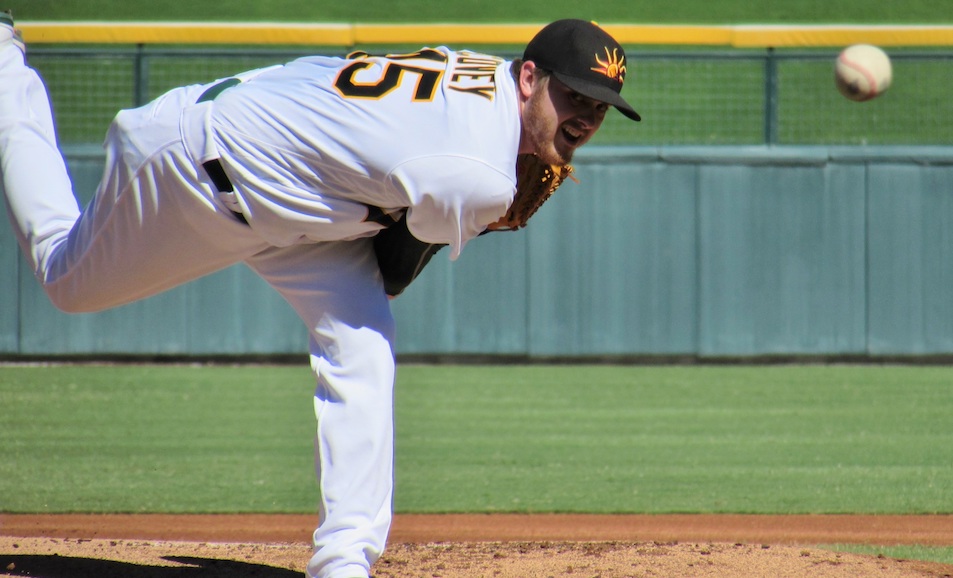Feature Photo: Dylan Covey, RHP, White Sox
(Photo by Kimberly Contreras)
When right-hander Dylan Covey suffered a significant oblique strain on May 8 in his sixth start of the season for the Double-A Midland RockHounds, he couldn’t have possibly known that it was his ticket to the big leagues. The injury cost Covey the final three months of the regular season, but it also opened another opportunity: a spot in the Arizona Fall League to make up for innings he lost while on the disabled list. His turn in the AFL opened a number of eyes and piqued the interest of the Chicago White Sox, who selected him off of the Oakland A’s Triple-A roster in the major league portion of the 2016 MLB Rule 5 draft.
Covey’s road to a spot on the White Sox’ roster was an unusual one. A top pitching prospect in high school, Covey was the 14th-overall selection in the 2010 MLB Draft. He didn’t sign out of high school, instead attending the University of San Diego, in large part to learn to live with his Type 1 diabetes diagnosis, which he received shortly after the draft.
After three years at USD, Covey landed with the A’s in the fourth round of the 2013 draft. Over the past four seasons, Covey has been a starter in the A’s system, moving gradually through the ranks. He spent the majority of his 2014 season in Low A before finishing the year with the High A Stockton Ports. In 2015, Covey was in the Ports’ rotation for the entire year, posting a 3.59 ERA in 140 innings in the hitter-friendly California League.
The 2016 season shaped up to be a make-or-break season for Covey, who flashed moments of brilliance in 2014 and 2015, but also struggled at times with his command. He got off to a solid start with the RockHounds in 2016, compiling a 1.84 ERA over his first 24 1/3 innings. The command issues still lingered – he walked 17 – but his 62% ground ball rate and an uptick in strikeouts helped to minimize the impact of the walks. Unfortunately for Covey, that was it for him for the season, as the oblique injury he suffered in the first inning his May 8 start didn’t heal in time for him to return during the regular season.
The A’s sent Covey to the AFL to recover some of the innings he lost to injury. He made six starts for the Mesa Solar Sox, and while his 4.74 ERA in 24 1/3 innings wasn’t particularly impressive, much of that number came from one bad start, when he allowed five runs in 3 2/3 innings. He was impressive in his other five outings, which included a November 1 start during which he threw the first five innings of a combined no-hitter (along with Frankie Montas (RHP, A’s) and Drew Steckenrider (RHP, Marlins) against the Surprise Saguaros. Covey made a strong last impression in the AFL when he threw five one-hit innings in the AFL Championship Game, leading the Solar Sox to the title and earning the win. The stats from that game weren’t included in his AFL totals, but it was likely his most important start of the fall given the high-profile nature of the outing.
Covey’s fastball showed plenty of life during the AFL season, averaging right around 93.5 mph. His best pitch is a sinker that he throws from 89-to-92 mph. That pitch generates a lot of ground balls, as shown by his career 2.35 GO:AO ratio. His four-seam fastball can touch 95 mph, but he doesn’t use it nearly as often as the two-seamer. Covey’s best secondary offering is a split changeup that also gets plenty of downward action. He also features a late-breaking, 11-to-5 shaped curveball, and he’s also recently started using a cutter.
Dave DeFreitas had eyes on Covey in Arizona, and filed this report.
Although Covey has been a starter throughout his career, he may find his way onto the White Sox’ roster as a reliever. His power arsenal has never produced a lot of strikeouts as a starter, but those numbers could increase in a relief role if he uses his four-seam fastball more often. His mechanics make it difficult for him to stay online to the plate consistently, which can cause control issues, but if he can reign in the walks and refine his mechanics, he could still have a ceiling of a #4/5 starter down the road.



